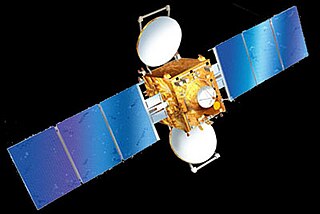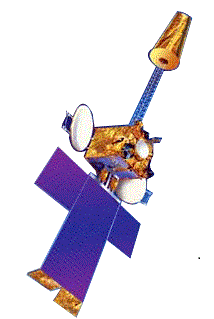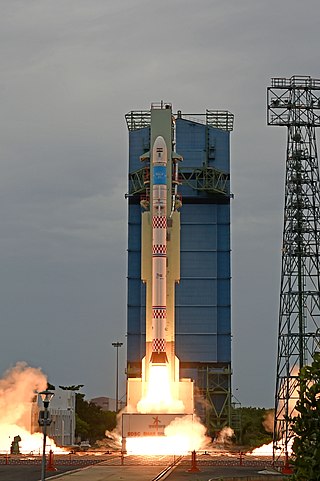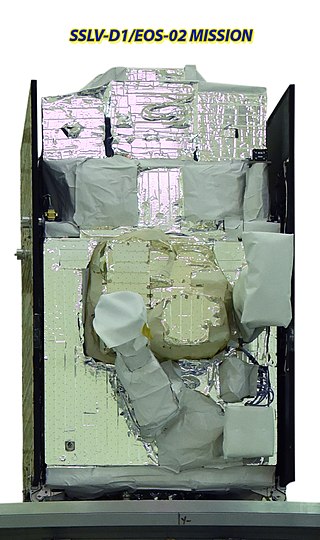
The Indian National Satellite System or INSAT, is a series of multipurpose geostationary satellites launched by ISRO to satisfy the telecommunications, broadcasting, meteorology, and search and rescue operations. Commissioned in 1983, INSAT is the largest domestic communication system in the Indo-Pacific Region. It is a joint venture of the Department of Space, Department of Telecommunications, India Meteorological Department, All India Radio and Doordarshan. The overall coordination and management of INSAT system rests with the Secretary-level INSAT Coordination Committee.

Geosynchronous Satellite Launch Vehicle (GSLV) is an expendable launch system operated by the Indian Space Research Organisation (ISRO). GSLV was used in fourteen launches from 2001 to 2021. Even though GSLV Mark III shares the name, it is an entirely different launch vehicle.
India's remote sensing program was developed with the idea of applying space technologies for the benefit of humankind and the development of the country. The program involved the development of three principal capabilities. The first was to design, build and launch satellites to a Sun-synchronous orbit. The second was to establish and operate ground stations for spacecraft control, data transfer along with data processing and archival. The third was to use the data obtained for various applications on the ground.
Satish Dhawan Space Centre - SDSC is a rocket launch centre (spaceport) operated by Indian Space Research Organisation (ISRO). It is located in Sriharikota, Tirupati district of Andhra Pradesh. Sriharikota Range was renamed in 2002 after ISRO's former chairman Satish Dhawan.

GSAT-4, also known as HealthSat, was an experimental communication and navigation satellite launched in April 2010 by the Indian Space Research Organisation on the maiden flight of the Geosynchronous Satellite Launch Vehicle Mk.II rocket. It failed to reach orbit after the rocket's third stage malfunctioned. The third stage was the first Indian-built cryogenic-fuelled upper stage, and was making its first flight. The ISRO suspects that the failure was caused by the third stage not igniting.

INSAT 3E is a defunct communication satellite built by Indian Space Research Organisation. It was launched on September 28, 2003, from the European Space Agency's spaceport in French Guiana on board the Ariane rocket. The satellite had a launch mass of 2750 kilograms. It is the 4th satellite launched in the INSAT-3 series for INSAT. It was designed for providing high-speed communication, Television, VSAT & Tele-education services and was an important landmark in Indian Space Programme.

INSAT-3A, a multipurpose satellite built by ISRO was launched by Ariane in April 2003. It is located at 93.5 degree East longitude. It is third satellite in INSAT-3 series after INSAT-3B & INSAT-3C. Built at a cost of $53 mn, it provides communication, weather, and search and rescue services.
IRNSS-1A is the first navigational satellite in the Indian Regional Navigation Satellite System (IRNSS) series of satellites been placed in geosynchronous orbit.

IRNSS-1F is the sixth navigation satellite out of seven in the Indian Regional Navigational Satellite System (IRNSS) series of satellites after IRNSS-1A, IRNSS-1B, IRNSS-1C, IRNSS-1D and IRNSS-1E. The satellite is one among the seven of the IRNSS constellation of satellites launched to provide navigational services to the region.

Dhruva Space Private Limited is an Indian private aerospace manufacturer headquartered in Hyderabad, India. Founded in 2012 by Sanjay Srikanth Nekkanti, the company is engaged in the development of small satellites in the commercial, governmental and academic markets. It provides full-stack space-engineering solutions across launch, space and ground segments – namely, the building, launching and operation of satellites.

EOS-04 or Earth Observation Satellite - 04 is an Indian Space Research Organisation Radar Imaging Satellite designed to provide high quality images under all weather conditions for applications such as Agriculture, Forestry & Plantations, Soil Moisture & Hydrology and Flood mapping. It is a follow on to RISAT-1 satellite with similar configuration. The satellite is developed by the ISRO and it is sixth in series of RISAT satellites.

This article documents notable spaceflight events during the year 2022. For the second year in a row, new records were set for the most orbital launch attempts and the most successful orbital launches in a year.

The Small Satellite Launch Vehicle (SSLV) is a small-lift launch vehicle developed by ISRO with payload capacity to deliver 500 kg (1,100 lb) to low Earth orbit or 300 kg (660 lb) to Sun-synchronous orbit for launching small satellites, with the capability to support multiple orbital drop-offs. SSLV is made keeping low cost, low turnaround time in mind with launch-on-demand flexibility under minimal infrastructure requirements.

EOS-02 was an Indian Earth observation microsatellite developed by the Indian Space Research Organisation as a test payload on the maiden launch of the Small Satellite Launch Vehicle (SSLV). EOS-02 was based on Microsat-TD. The objective behind EOS-02 was to realize and fly an experimental imaging satellite with short turnaround time to showcase launch on demand capability.

The PSLV-C54 is the 56th mission of the Indian Space Research Organisation's Polar Satellite Launch Vehicle (PSLV). It was launched on 26 November 2022 with the EOS-06 satellite and Thybolt nanosatellites of Dhruva Space from Satish Dhawan Space Centre, Sriharikota, Andhra Pradesh, India.

The SSLV-D1 was the first mission of the Small Satellite Launch Vehicle (SSLV). Due to a sensor fault during separation of second stage and subsequent initiation of Open Loop Guidance by onboard computer to salvage the mission, the upper stage did not fire for planned duration and payloads were ultimately injected into a decaying orbit not achieving the objectives of mission.
The SSLV-D2 was the second mission of the Small Satellite Launch Vehicle (SSLV). The vehicle carried three payloads: EOS - 07, Antaris US Firm named as Janus-01 and AzaadiSAT-2 by SpaceKidz India.













